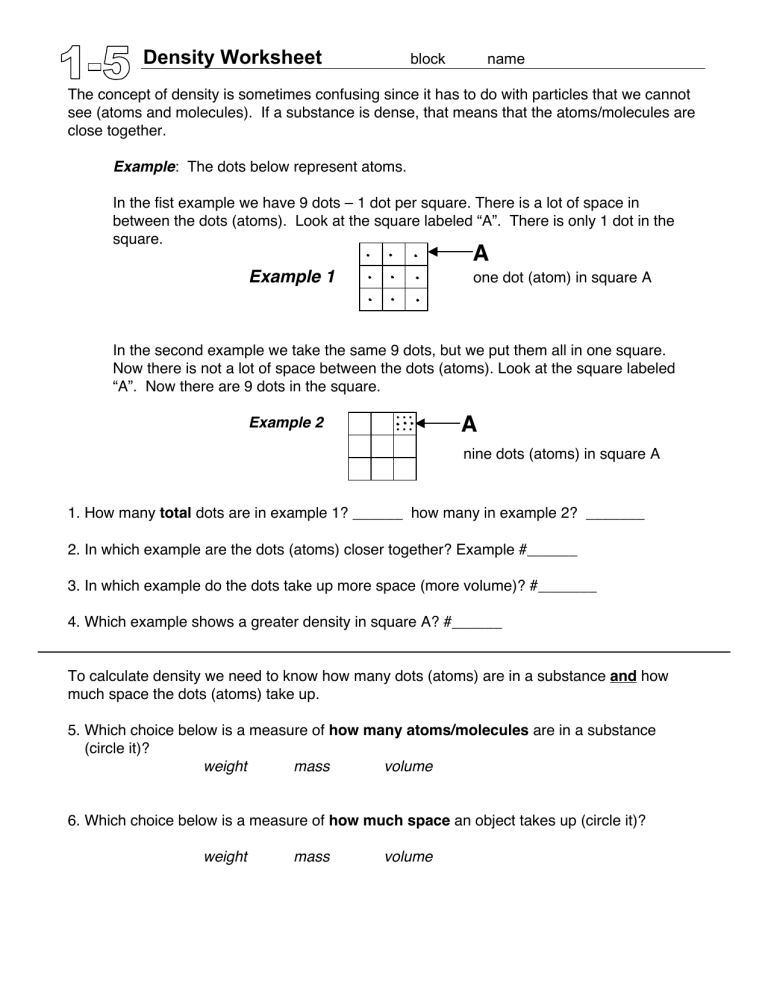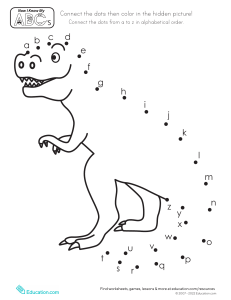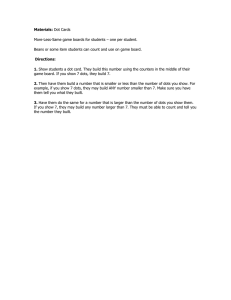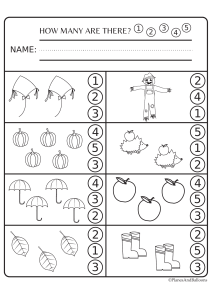
Density Worksheet block name The concept of density is sometimes confusing since it has to do with particles that we cannot see (atoms and molecules). If a substance is dense, that means that the atoms/molecules are close together. Example: The dots below represent atoms. In the fist example we have 9 dots – 1 dot per square. There is a lot of space in between the dots (atoms). Look at the square labeled “A”. There is only 1 dot in the square. A Example 1 one dot (atom) in square A In the second example we take the same 9 dots, but we put them all in one square. Now there is not a lot of space between the dots (atoms). Look at the square labeled “A”. Now there are 9 dots in the square. Example 2 ••• ••• • A (nine dots (atoms) in square A 1. How many total dots are in example 1? ______ how many in example 2? _______ 2. In which example are the dots (atoms) closer together? Example #______ 3. In which example do the dots take up more space (more volume)? #_______ 4. Which example shows a greater density in square A? #______ To calculate density we need to know how many dots (atoms) are in a substance and how much space the dots (atoms) take up. 5. Which choice below is a measure of how many atoms/molecules are in a substance (circle it)? weight mass volume 6. Which choice below is a measure of how much space an object takes up (circle it)? weight mass volume Density Worksheet block name Since density shows how many particles (mass) are in a certain amount of space (volume), the formula for density is … Density = mass / volume (mass divided by volume) The unit for density is grams per cubic centimeter (g/cm3) Calculate the densities of the following objects. You will need a calculator. Round all answers to the tenths place (1 place after the decimal) 7. A shoe box mass = 114.0 g 3 volume = 538.5 cm 8. a rock mass = 22.3 g •density = ____________ g/cm3 9. A full soda bottle mass = 609.0 g volume = 8.0 cm3 • density = ____________ g/cm3 volume = 591.0 mL 10. a dry sponge mass = 54.2 g volume = 78.1 cm3 •density = ____________ g/cm3 •density = ____________ g/cm3 11. When a dry sponge absorbs water, which changes most (circle one)? A. the sponge’s mass B. neither changes, mass and volume stay the same C. the sponge’s volume 12. The sponge in question #10 absorbs 277 grams of water. Recalculate its density. *show your work 13. a) You drink all of the soda out of the bottle (from question #9). The soda had a mass of 570 grams. Recalculate the density of the empty soda bottle. *show your work b) Why did the density of the bottle of soda change?





